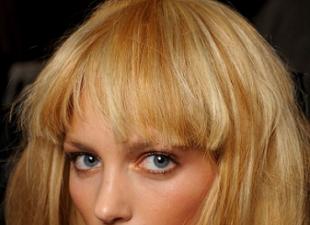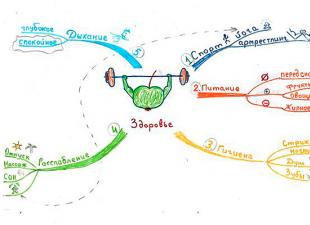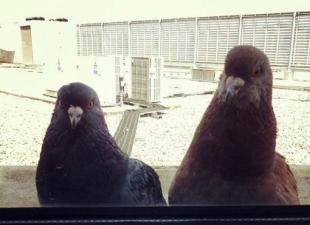The most common group of pigeons among breeders are decorative. They differ from other breeds by their various colored feathers and unique appearance. Selection of decorative pigeons is of great interest among specialists. The plasticity of these numerous breeds, along with its variability, effectively helps to conduct hard work aimed at maintaining and improving the birds of this group. We will talk about the most interesting and extraordinary now.
Features of decorative birds
The most distinctive and, perhaps, the main feature of these breeds is that they can be bred not only by professionals in their field, but also by amateurs right on the balcony of an apartment. All this is due to the fact that pigeons are unpretentious to their environment habitat and content. That is why birds can be kept, for example, in a room aviary, or in other similar unspecialized places. The very type of decorative pigeons was bred by crossing rocks.
Decorative pigeons from others with their unique appearance, for example, peculiar natural ornaments, tufts or long feathers. Also, pigeons attract particular attention with their posture, body shape, and of course, feather color. So, for example, there are certain species that have the color of other wild birds; accordingly, they are called swallows, seagulls, storks, and even bullfinches are called there. The purpose of breeding such pigeons is exclusively aesthetic pleasure from their beauty. There are a lot of names of such breeds, let's talk about the most popular among them.
Jacobins
The main difference of this species is their so-called decoration, consisting of feathers known as a collar. The necklace is located around the head, while covering the neck and the entire head of the bird. For prophylaxis during nasidka in chicks, the collar is slightly trimmed, for its further preservation. Bird by nature slender with a pronounced long neck. The color of the Jacobins is the most diverse.
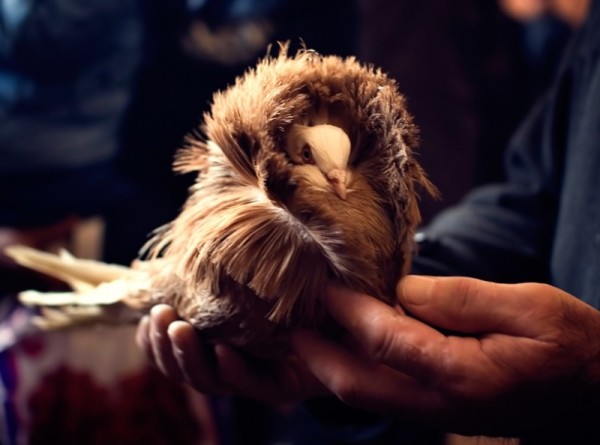
Legs of pigeons of this breed are rather short, while their tail is long. They fly very slowly, in comparison with other breeds, and it is hard for them. The Jacobins hatch eggs very productively and with all that, while still being exemplary parents. The very common name of the Jacobins is English; wigs. They got the specific nickname because of their appearance, namely due to feathers on their heads, which at first glance resemble a wig.
Decorative pigeons are also very shy, so the treatment and care of them should be carried out carefully and carefully, regularly monitor their behavior. Bad flight in birds is developed due to poor vision, which, in turn, deteriorates due to the so-called wig. At the moment, the Jacobins are considered the most popular decorative pigeons, but at the same time their qualities are very far behind those of foreign birds.
Curly
Every pigeon breeder is dreaming to have this pigeon in his collection. Curly plumage of this bird is so unique that even on a monochromatic gray color looks just amazing. The most densely swirling places, as seen in the photo, are the wings and legs.
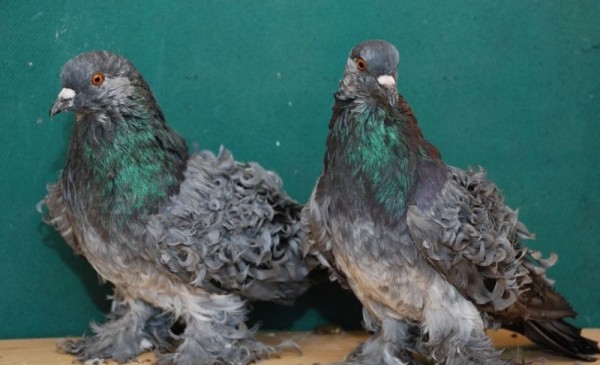
Peacock
It is possible to say with great confidence that it is the representatives of this breed that are the most beautiful in the decorative direction. The main distinctive feature of a pigeon's appearance is a wide tail, very lush feathers, and the combination of these visual elements creates the so-called peacock effect. White coloring of feathers such as in the photo, is considered the most popular among birds, although there are other colors in various dovecotes. These pigeons are frequent participants in circus performances as well as wedding ceremonies.
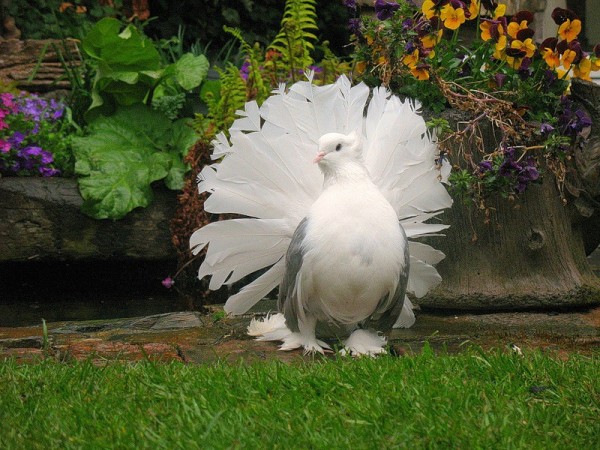
The breed of these unique decorative pigeons was bred in the distant Czech Republic. The main feature of this species is the color on the wings and paws of the birdie, which immediately reminds us of the well-known swallow. Bohemian kosmonogaya large in size bird, the main distinguishing feature of pigeons is their plumage on the legs.
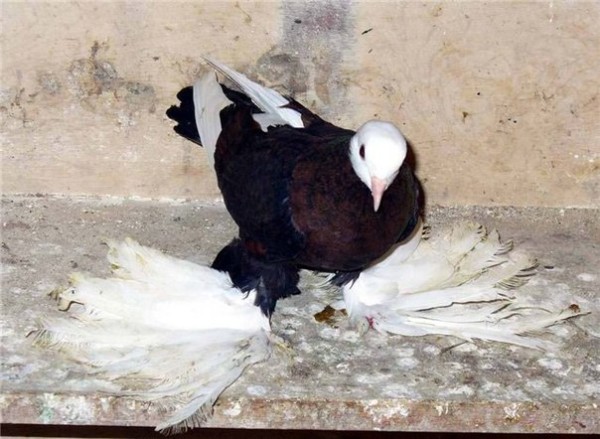
Barb
These pigeons are easily distinguished from other subspecies, due to their specific pink growths around the eyes. All this because birds belong to the class of warty. Also, Barbov has a short beak and a prominent bulging forehead. There are practically no variegated colors of these pigeons, they are mostly monochromatic, the most common are white.
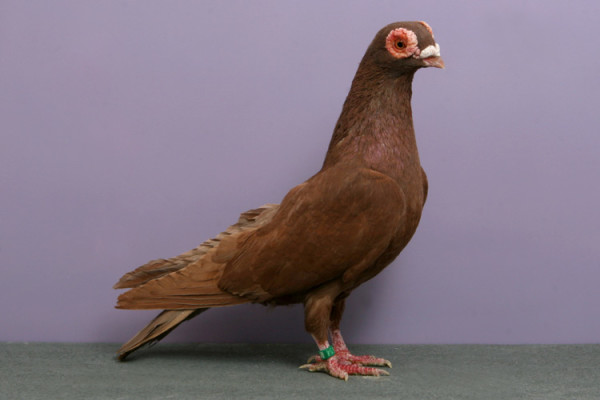
This is only a small part of the decorative rocks. There are still many different, beautiful pigeons in the world. You have already learned and seen the most popular and common representatives of this species.
Photo Gallery
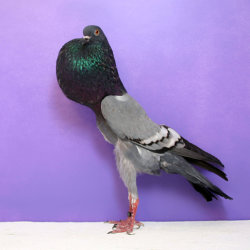 Photo 1. Pigeon of breed Brno blow
Photo 1. Pigeon of breed Brno blow
 Photo 2. Pigeon of breed Saxon priest
Photo 2. Pigeon of breed Saxon priest
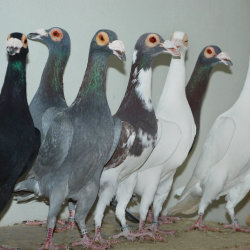 Photo 3. Several pigeons of the Barb breed
Photo 3. Several pigeons of the Barb breed
Video "Jacobin Pigeons"
This video shows how this breed lives in a dovecote.
In Russia, since ancient times, pigeons were bred and revered. The first written mention of domestic pigeons was recorded in the Tale of Bygone Years. For a long time chasing pigeons or “pigeon hunt” was one of the favorite pastimes of the Russian nobility.
The first "official" pigeon breeder in Russia who made a serious contribution to the selection of pigeons was Count Alexei Orlov. For his pigeons brought birds from different parts of Russia, Turkey, Greece, England, Germany. Thanks to his efforts, the pedigree qualities of modern boroduns and Oryol turmans were laid.
Many of the Russian breeds of pigeons were formed by the beginning of the 20th century.
By the middle of the XIX century, the breeding of pigeons ceases to be the prerogative of the nobility and acquires national importance. The pigeon post office is organized, the first pigeon nursery opens at Moscow University, books and magazines devoted to pigeon hunting begin to be published, exhibitions are organized.
By the beginning of the twentieth century, many Russian breeds of pigeons were formed.
After the revolution, golubevodstvo declined. In the 30s, the pigeon population sharply decreased. The owners of pigeons were accused of espionage, the transfer of secret data by pigeon mail. Birds destroyed. The owners were sent to the camps. Even more, the number of birds decreased during World War II. A large number of primordial Russian breeds disappeared forever.
In the postwar years, amateurs and professional breeders began to revive their favorite breeds. Today, there are more than two hundred registered domestic breeds in the country, many of which are recognized by the international communities of pigeon breeders.
Important. The most popular domestic breeds are: stately pigeons, Russian turmans, Astrakhan, Volga, Voronezh, Tula, Chelyabinsk, Baku pigeons, Chinese seagulls, high-flying pigeons, rooks, grivunas, Tula beetles, swans, chiliks.
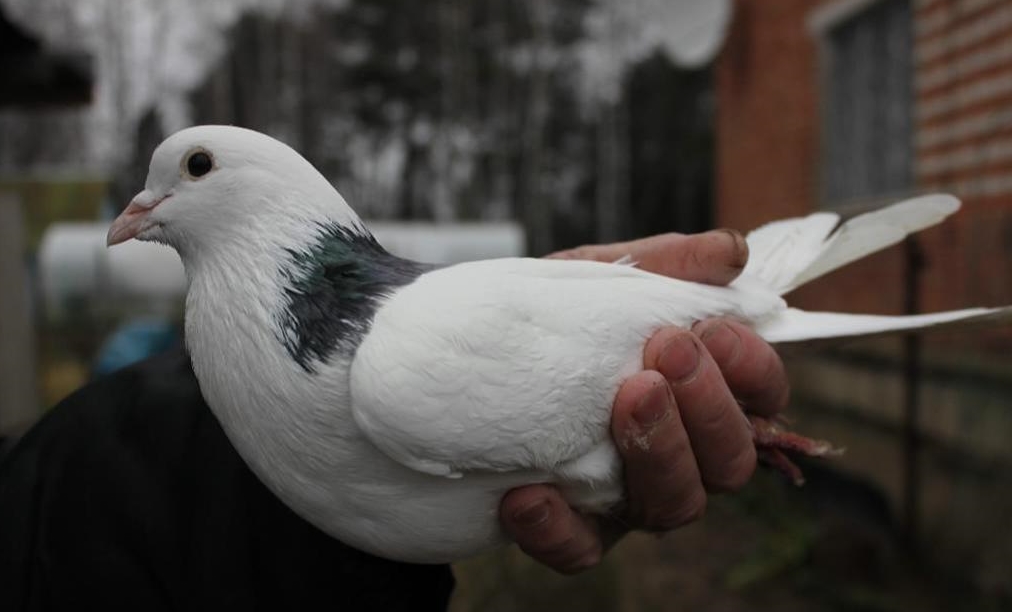
Grivuny (Permian) - one of the old Russian breeds. In an article published in 1888 in the journal Nature and Hunting, it was stated that the breed had formed and spread by the beginning of the 19th century. Its author called the “parents” of grivunas — the blue Dubovka, Kamyshin pigeons and the white Penza turman.
Appearance, addition of hryvnias testify to excellent flight qualities:
- body length 35-47 cm;
- head rounded, medium in size, smooth;
- eyes are clear, dark;
- plumage dense.
In our time, several varieties of hryvnas are bred, differing in color and flight characteristics:
- Permians are white birds with a blue, black or red mane. Excellent flyers with a developed spatial orientation. Able to stay in the air for up to 10 hours, especially strong individuals - up to 12 hours. They fly even in a discharged atmosphere at high altitude.
- Southern grivunas (Kirov, Nikolaev) are smaller birds, with a neck and back of yellow, black (Chubariki) or red. They differ in flight style: in 2-4 hours, the pigeon descends several times and then re-gains its original height.
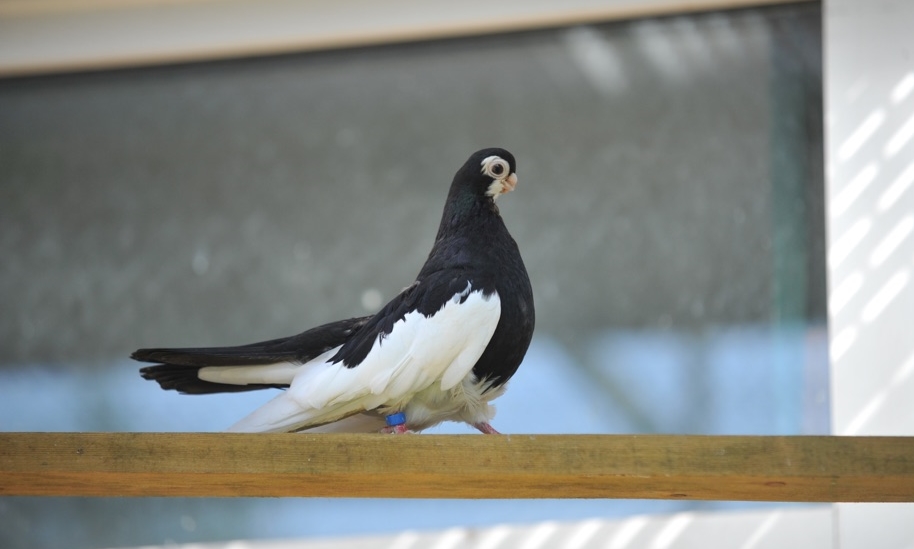
Black-piebald (black-roan, Kaluga) turmans originate from Orlov boroduns and Oryol white pigeons, gray turmans.
The standard was officially approved in 1912:
- average bird size, 34-36 cm;
- long wings sweeping, the ends go down below the tail;
- body wide, elongated;
- rounded or faceted head with a prominent high forehead, small;
- eyes are large, expressive, dark, bulging;
- white beak, slightly curved downwards, short, strong;
- color black with green tint and weed pattern;
- belly, thighs, cheeks, chin, wings just barely white;
- in a black tail 12 tail feathers;
- short feet;
- the standard allows for both the presence and absence of a forelock;
- orlovtsev’s initial excellent flight qualities were lost during breeding, the flight duration is small, the bird turns hard;
- typical flight on a wide high circle with a series of flip-flops (katov).
Known subspecies of black and white pearl on a black background, characterized by black cheeks, chin, chest, thigh.
Important. Black and piebald turmans have recently been bred as an ornamental bird.
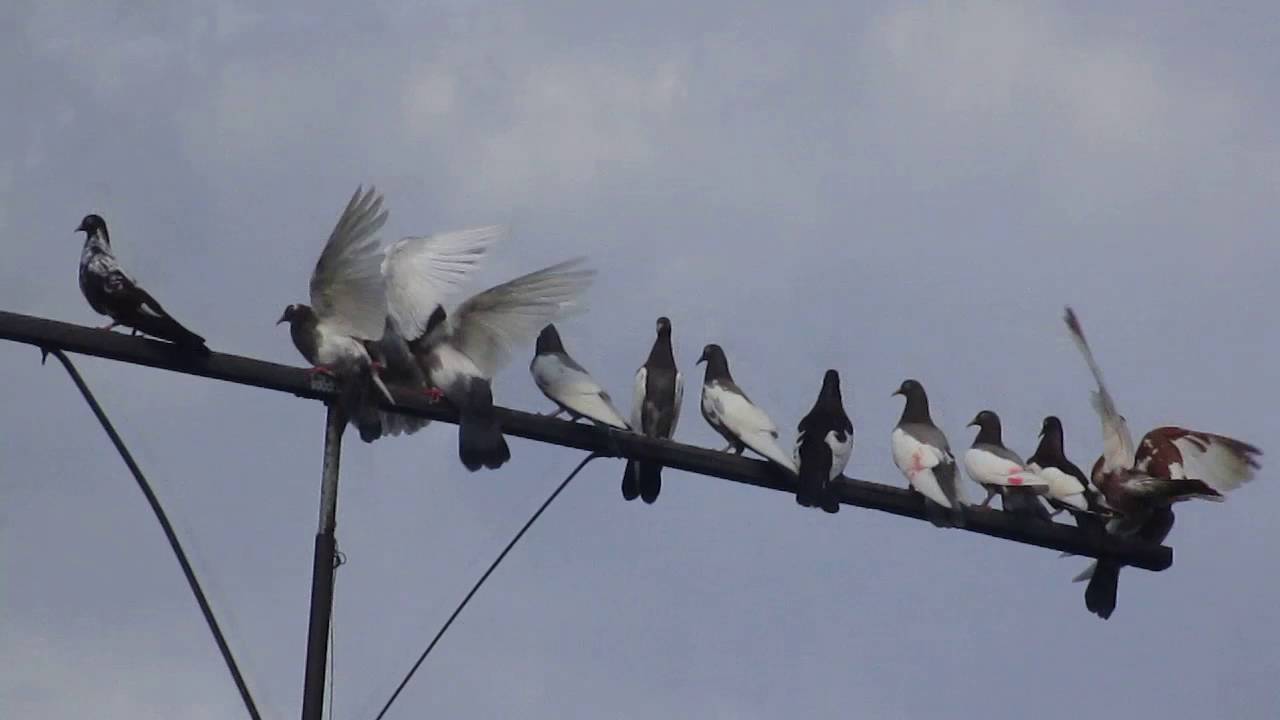
The name received from the Volga city Dubovka in which they were withdrawn. There is another local name - Kondratyevsky.
The main characteristic of the Dubovka pigeons is a lingering, muffled uterine cooing.
They belong to the high-flying pigeons. Fly in a small circle at high altitude. Dubovtsy can be in the air up to 8 hours, have a developed spatial orientation.
In the descriptions of the Dubovka pigeons, the required parameters are indicated:
- medium-sized white winged bird with slightly raised tail;
- landing low, bare, non-feathered legs short, red (crimson);
- a tubular head of an oblong shape with a small low forehead, the nape in the form of a tubercle and a flat temechkom;
- slightly curved neck of medium size;
- trunk slightly elongated, with a wide and well-developed chest;
- long, up to 24 mm, straight white beak;
- the color of the body, tail, head, neck is agony, gray-white, pure white, gray-blue (gray), red;
- wings with colored feathers-epaulettes on the shoulders;
- tail up to 24 mm in length from 12-14 feathers, with a dark ribbon at the end;
- eyes are bright, silvery.
Reference. The content is unpretentious. Have a developed parental instinct.
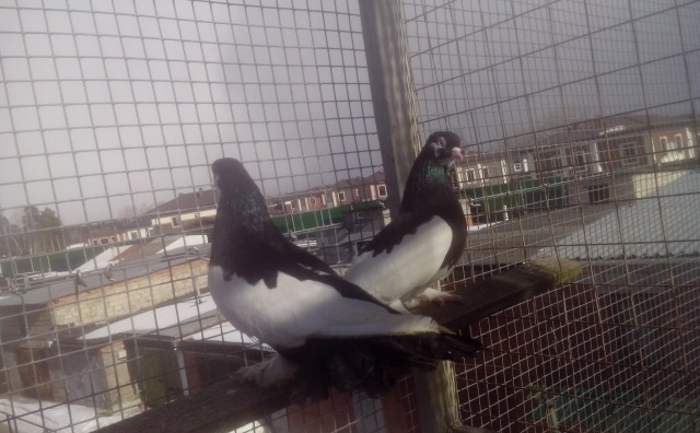
Kamyshin pigeons or canes come from Volga Kamyshin. Breed group was formed by the end of the XIX century on the basis of gray pigeons. The reeds were derived for the favorite joy - "rut" and belong to the group of stately pigeons.
The flying qualities of pigeons are excellent. They are devoted to the house, they always find the way to the nest, they are perfectly oriented. Fly alone or in a flock of high circle.
Reeds:
- evildorated proportional birds, with a body length of 35-38 cm;
- the main color is pure black, there are local subspecies with yellow, blue, fawn, coffee, red plumage, the standard allows a metallic sheen on the neck and chest corresponding to the basic color, the wings of any basic color are pure white;
- plumage tight to the body;
- narrow head oval, slightly elongated, smooth, with gentle any:
- large eyes pinkish gray or yellowish, large, with narrow grayish eyelids;
- middle beak, tightly closed, pink;
- legs are bare, short, crimson, claws are white;
- wings strong, long;
- there are no shields and belts;
- tail flat, raised, without a white ribbon at the end.
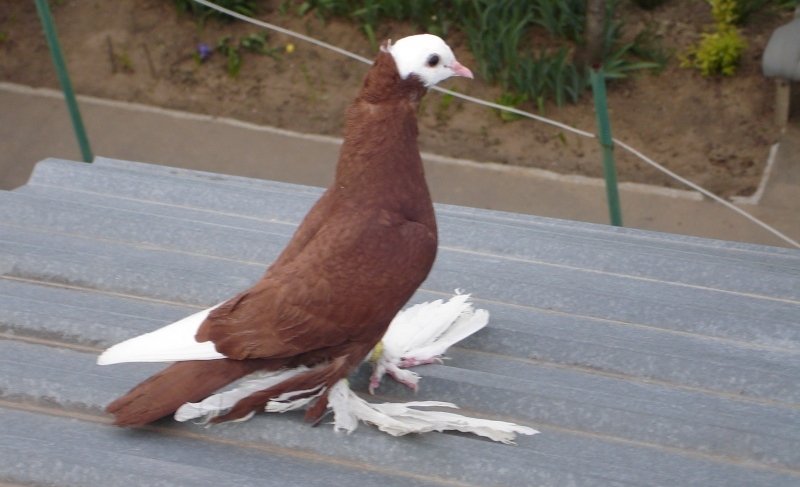
Work on breeding was carried out in Armavir since the end of the XVII century. The source material was the North Caucasian long-billed kosmachs. Armavir white-headed kosmachs are included in the International catalogs of breeds of pigeons. Breed is considered one of the most beautiful, elite and rather expensive.
A characteristic feature of birds is a rich abundant plumage on the legs (kosma). There are chubaty and bezbuby subspecies.
Breed characteristics include:
- high feathered legs with long spurs;
- stately proud posture;
- long white beak;
- intense color - yellow, black with a red tint (burnt), red, black, gray with a faint yellowish or reddish tinge (sparrow) in combination with white plumage on the head and wings;
- on the edge of feathers with wide veil, a darker rim — a scale;
- long wings converging to the back.
They fly up to one and a half hours at an altitude of 50-100 meters. The style of flight is smooth, with a light influx, entering a vertical 10-meter pole with a loud, dry battle, with 3-5 coups, with 2-9 coups during descent .
Important. Armavir bald (bald) are included in the group of fighting pigeons.

The breed was bred by Volga breeders on the basis of Kazan shakers, Rzhev pigeons and North Caucasian colored kachuns. Pigeons are bred as an ornamental breed, although some individuals show good flight qualities.
Among the racial characteristics of the Volga red breasts:
- small, short body, similar in structure to Kachuns;
- high raised wide tail of 16-18 feathers with a transverse white stripe;
- spectacular cherry-white suit;
- head, main body, tail rich cherry, shiny, feathers on the chest and neck with a purple tint;
- cheeks, throat in upper part, podklbve, abdomen, legs, wings and white and white;
- short legs with plumage in the form of a bell;
- round smooth head;
- eyes pinkish, with dark impregnations and a pupil;
- a thick small fawn-pink beak;
- a neck with a beautiful, proud bend, a pigeon shakes it, justifying its belonging to the group of shakes;
- massive pink beak;
- shields matching in color with the main.
The standard allowed yellow color with a white stripe on the tail and pure black without white tail decoration.
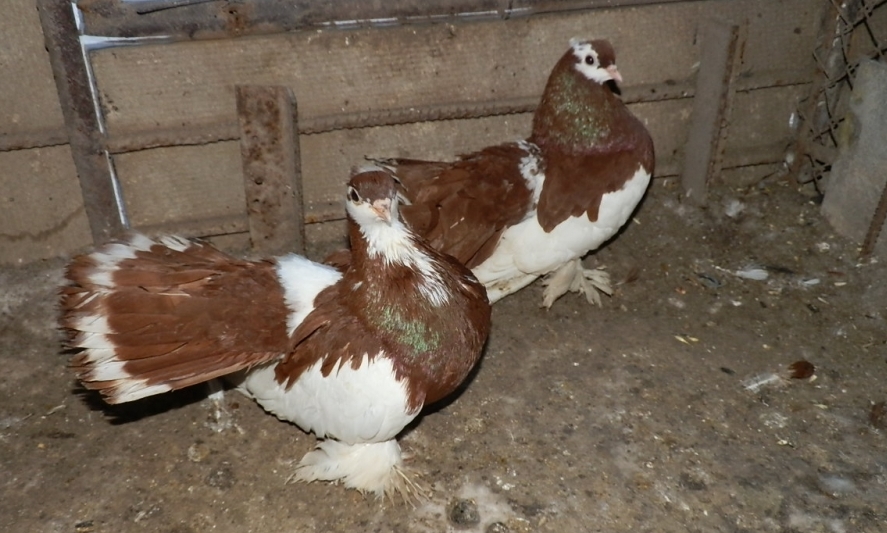
Volga band pigeons hail from central Russia. The breed was formed by the wing-winging pigeons from Syzran and Rzhev. Decorative qualities and color brought Volga red breasts.
With proper maintenance and regular training, pigeons show good flying qualities. Able up to 3 hours to fly slowly over a wide and high range.
They are distinguished by tenderness and loyalty in relation to the chosen partner; they often show tenderness towards each other, good caring parents.
Their standard is similar to the standard of the Volga red breasts:
- cherry white or lemon white plumage color;
- a wide raised flat tail is decorated with a white stripe up to one and a half centimeters wide;
- head round with flat crown and broad forehead;
- dark eyes;
- light pink beak wide at base, short, pointed towards the end;
- proudly arched thick neck of medium length;
- trunk shortened, with a wide chest and back;
- wings long, lower than tail;
- short legs are feathered;
- posture, stately, stately, differ in power temper.
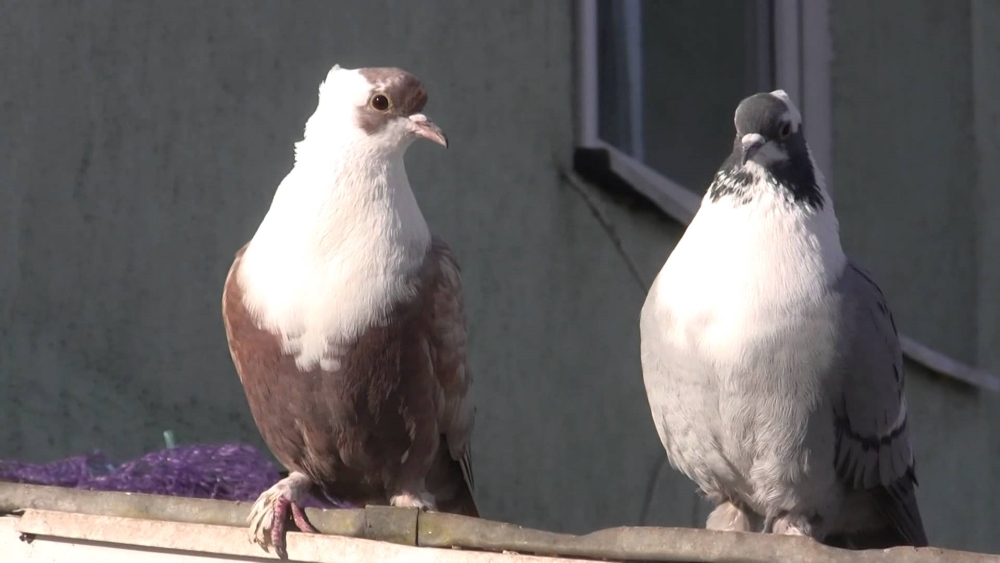
Voronezh white-eyed (Voronezh white-toed-white-belted, bearded) is one of the oldest domestic breeds known since the time of Catherine II. They belong to the breed group of pure pigeons in Voronezh.
Stand out among other breeds flight style. Without making circles, a dense group of birds confidently gains altitude, slows the flight, and, after a short time, turns around, rising higher. At high altitude, the flock stretches into a chain, sometimes the birds "go into motion" - swaying from side to side. Fly up to 2 hours. Go down to the dovecote in circles.
Breed traits include:
- dry, strong format, developed muscles;
- body length 32-34 cm;
- bulging wide chest;
- dense, rich plumage of the main light gray-blue color with glitter;
- light gray or white head and neck;
- an elongated head shape adorned with a beard, a flat little forelock and a colored forehead;
- eyes are dark, shiny;
- thin long beak of dark color;
- long, well developed, wings tight to the body;
- legs with feathers drooping down to fingers;
- straight full tail.
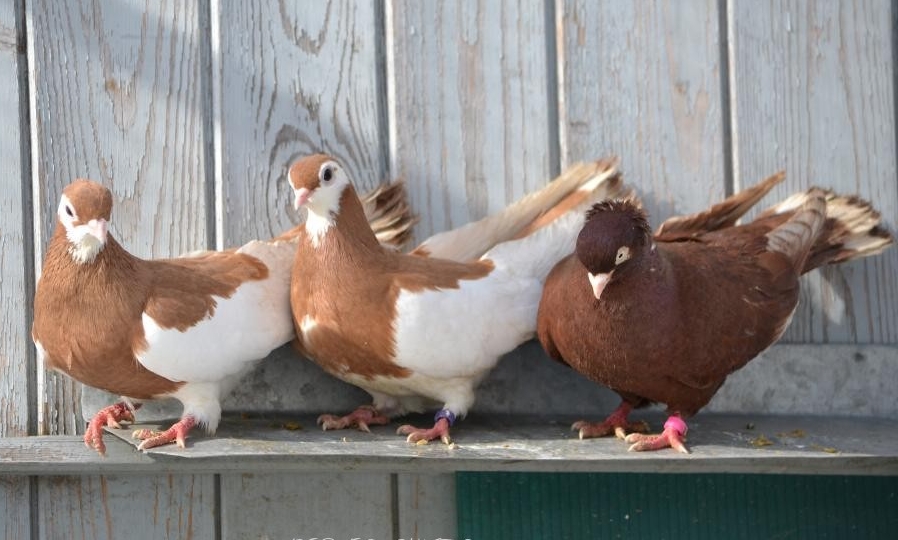
Homeland coffee Turman city of Tula. In fact, it is a subspecies of Tula beetles. The exact origin of the breed has not been established. Among the pigeon breeders there is an opinion that Smolensk rough rooks (Lobachi) participated in the formation of the breed.
By racial characteristics include:
- a wide faceted cubic head with a broad forehead characteristic of domestic Turmans;
- large light silvery moist eyes with white eyelids;
- wide forelock;
- red and brown suit of different shades from dark coffee to pale yellow;
- on the neck feathers with green tint;
- powerful thick short beak;
- leathery rim around the eyes of a light cream color about 2 mm wide.
Important. The population of coffee Turmans is small. The bird requires careful care, choosy to the conditions of detention, feed.
Spartacus
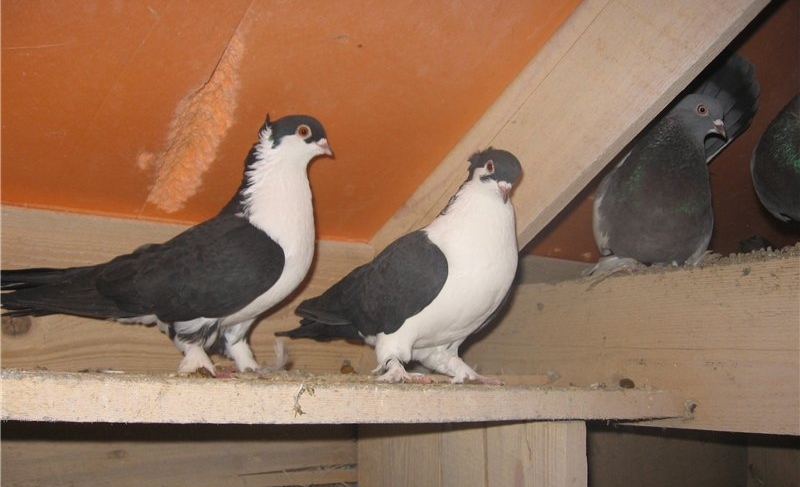
Spartaki relatively new breed. It was bred by Bashkir golubevodami at the beginning of XX century on the basis of Staroufimskoy black and white breed of pigeons.
Breed standard adopted in 1981:
- body size 33-35 cm;
- the constitution is strong, elegant, the format is strong;
- color saturated, two-color, with glitter;
- the main tone is black, gray, red, white color of plumage only on the abdomen;
- between the base of the beak and the eyes of the "earrings" - colored feathers;
- head round, with a small low forehead, forelock crest on the occipital part up to 5 mm high;
- eyes shining, yellow-red with yellow-pink eyelids;
- medium-sized straight white beak, gray mandible (horny);
- neck strong, thick;
- the wings are well developed, strong, tight to the body, elastic, the ends reach the tail;
- colored shields;
- short legs feathered "stockings";
- tail of 12 tail feathers, narrow.
They belong to the group of high-flying pigeons, have good flight characteristics.
In flight, Spartaki "keep the line." Always fly cohesive, dense pack. The flight is long, high, in a small circle.
Cultivation of pigeons is an ancient occupation. The first references to the domestication of these birds date back to about 3000 years BC. To date, the practical value of this poultry industry has declined slightly, but this has had little effect on its popularity. As an object of breeding, decorative pigeons stand out, for which there are a variety of applications. This should be discussed in more detail.
≡ Content
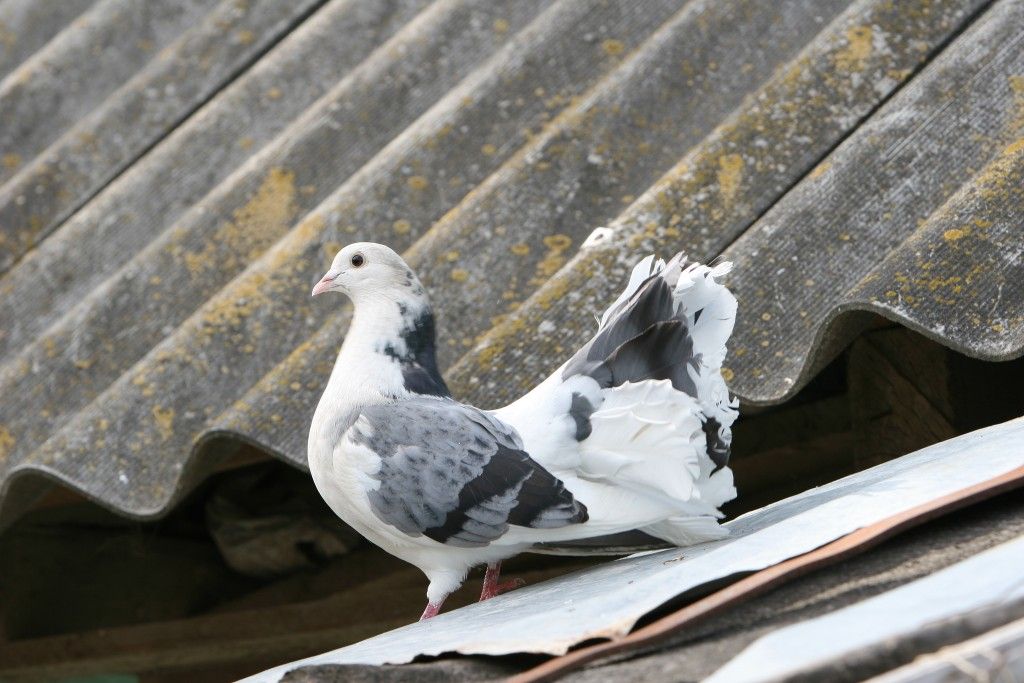
general information
Of course, all decorative breeds of pigeons have a beautiful and exotic appearance. Moreover, this may concern both the color and shape of the plumage, and the body or individual features, for example, beak, paws or eyes.
To obtain similar results, crossbreeding of various species of pigeons is used, ranging from wild to combatant with their relatives, near or far. The point is that either other breeds of pigeons or even other species of birds act as partners. The latter is also practiced, albeit somewhat less often due to greater complexity and riskiness.To breed any decorative breed of pigeons, you need to thoroughly examine its weaknesses in terms of nutrition and disease. And among these beauties there are quite unpretentious representatives, but there are not as many as we would like, therefore, in any case, each novice pigeon breeder in Russia or Ukraine should choose not only photos and videos of birds, but also recommendations for content.
Breeding goals
Now it's worth talking about why decorative pigeons are bred throughout Russia from Moscow to Altai. Yes, you can say that "for beauty." However, this definition is too vague and does not provide a full understanding of the issue.
So, the main objectives of the application of decorative breeds of pigeons:
- events (weddings, school calls, business openings, diplomatic events, etc.);
- props for performances in the circus;
- as pets.
Now it is worth considering these moments in more detail.
At various events in Russia, especially weddings and school bells, decorative pigeons are often reserved for the final part. When their turn comes, the birds (usually white) are released as a symbol of peace, love and freedom. Such a conclusion gives the holiday a special mood.
In circuses, pigeons also often act as beautiful designs or even as independent numbers. Of course, they are separately trained for this, although, given that they do not require particularly complicated tricks (in most cases), usually everything is limited to the decorative component.
In the same capacity, photographers often use them to create romantic photos.
Finally, a nice pet can come out of a decorative pigeon. However, there are certain risks. Unfortunately, these are quite temperamental birds, and in some cases can pose a risk to children and, sometimes, adults, therefore, the breeder’s task is to send for sale only balanced and calm individuals. In Russia, this business is still not very popular, but it continues to gain momentum.
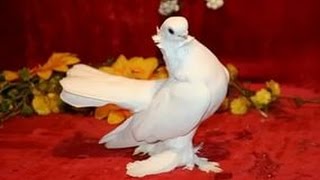
You can discuss the video on the website of the animated video http: //
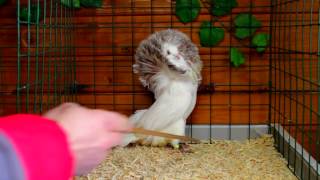
Decorative pigeons of Belarus. Jacobins
Decorative pigeons Nikashkina S.
Enver +79788981805.
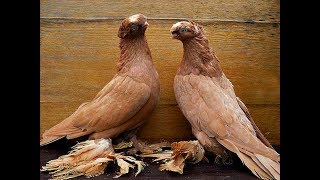
Decorative uzbek double-eared pigeons. (Crimea) +79788981805
Enver +79788981805.
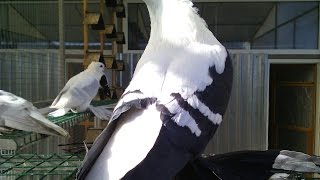
Decorative Pigeons / Porumbei Decorativi (A. Magomedov, p. Vladimirovka / Stavrop.kray, Russia)
if you have an interesting video with pigeons and x
Main breed
Today, there are dozens and even hundreds of different breeds of decorative pigeons, but some of them are particularly popular and prevalent. For various reasons, although, as a rule, they consist in a combination of beauty and unpretentiousness, as well as a calm character (especially for future pets).
Peacock
It is considered one of the most beautiful and at the same time popular breeds of decorative pigeons. The latter is caused by the white coloring that is common among them (although other colors and even their combinations are also encountered), as well as by a beautiful, really “peacock” tail. It is these pigeons that are considered the main image of the “birds of the world” and the corresponding posters were drawn from them (first of all, agitation).
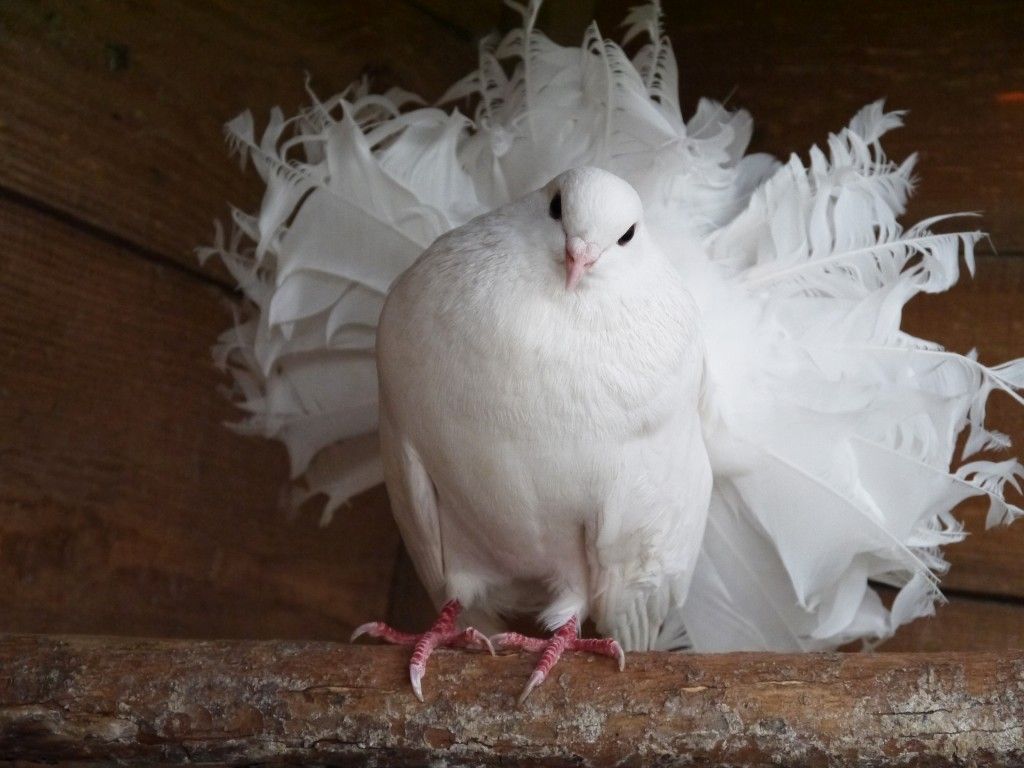
The appearance of these birds is very proud. They look “volumetric”, have a highly raised chest, and with their nape they touch the feathers of the lower part of the body. In a relaxed atmosphere, the pigeon rests on the entire paw. If it is necessary to show off in front of a female, then he rises “on tiptoe” and swings. This particular flirt is characteristic not only for this breed, but also for many others.
One of the main advantages for which this breed is appreciated by golubevody, is their fecundity. Given that the beauty passes from them, it can be said, by inheritance and almost guaranteed, the high number of birds promises an equally high profit for the owner of the pigeon farm, including in Russia.
In order to increase the commercial value of the breed, many breeders specially train them for beautiful flying circles. The success of this moment varies, although as a rule pigeons learn relatively quickly what is required of them. The rest of the special "additions" is not required. The movements of these birds are very graceful, and the character, in most cases, is quite gentle.
Barb
Enough specific breed. Refers to wart pigeons. For some of those who have little knowledge, such a name causes hostility. However, the name has almost no relation to warts. Just all the representatives of these breeds have their own unique leathery formations.
This moment is, of course, and the barbs. Their distinctive feature is the unusual and very noticeable round rims, growths around the eyes and beak, although this does not end with the appearance. They still have a very prominent forehead and a rather short beak, which seems even shorter due to growth.
Barbs are exclusively monochromatic in color, not motley among them. There are beige, sizie, but here the most popular are white.
Brno blow
A breed with such a difficult name has a very specific appearance. So specific that it is almost impossible to confuse it with any other.
Why? The fact is that the name “dutysh” did not originate from scratch: these pigeons have a huge goiter, about the size of their abdomen. Only this moment attracts attention, although not everyone likes it. But here everything is, as they say, an amateur.
One more specific feature of the Brno blowers is the “soldier” stand. They have a very straight and very high body position with rather long and straight legs. This creates the impression that the bird is standing at attention and is about to start marching.
Curly
Already by name it will not be very difficult to determine what is the distinguishing feature of this breed. Although this is somewhat difficult to believe, even looking at their photos. Yes, these pigeons have curly feathers. And they do not look like a natural creation, but as a long work of a qualified stylist. Although, we can say that the breeders, who bred this breed, acted as the last.
Curly parts do not cover all plumage. Head and goiter have the usual feathers. The strongest curliness on most of the wings and a little on the feet. The tail looks as if it is covered with a kind of scales. Such "fans" not only look beautiful, but also serve as a kind of ventilation.
Coloring here can vary a little, however always there is one invariable line: a white forehead. In addition, the tail is usually lighter than the rest of the body. The most common beige, brown and gray colors. Occasionally there are white birds that look just magical.
Saxon priest
This breed may be somewhat inferior to its brethren from this list in popularity, but not in beauty. The name here, again, is not taken from the ceiling. The crown of the birds of this breed is always exceptionally white and resembles an embroidered tonsure. Also worth noting are two tufts on the head and a specific “collar” on the back of the head.
True, the Saxon priest cannot boast of a particularly impressive color. The most common plumage with its flowers is almost identical to the gray urban outbred pigeons, although, in combination with the shape of feathers, it looks quite beautiful. In addition, it is this color that best suits the name.
Bohemian kosmonogaya magic swallow
Such a complex name has very beautiful pigeons. Their wings in shape really resemble swallowtails, albeit of large dimensions. The distinctive features here are not in the form of feathering, as in most decorative breeds, but in color.
The fact is that the Bohemian Astronomical Swallow has a strikingly beautiful color of feathers. As a rule, they are painted in two colors, which are arranged in a checkerboard pattern. As they say, simple and tasteful.
English Cross Dove
This decorative breed of pigeons was bred in the UK. To date, such birds are very common in European countries. The second name is "Dove Nun." They called him so because of the peculiar hood of feathers on his head.
The constitution of these "crusaders" is rather dense, with a vertical posture. The body is short with wide shoulders and neck of medium length. The comb is very large and beautiful, and the head is wide, massive and with a high "aristocratic" forehead. The length of the beak usually does not exceed 1 cm.
The color of the breed is as follows: most of the body is white, but the head, apron, tail, some feathers on the wings are painted in some other color. Most often - in black. This combination really gives the bird some resemblance to a nun.
Hungarian high flying pigeons
Hungarians also own a couple of breeds of pigeons, including decorative ones. More precisely, their breeders. They differ from other beautiful breeds in their remarkable flight duration (of course, for this species) - from 5 to 10 hours.
The color of the plumage of Hungarian high-flying pigeons can vary greatly. Their main advantage is body shape. She is all talking about the ability of birds to fly. Their physique is quite dense and elongated, like a torpedo.
Due to the fact that representatives of the Hungarian breed are often excellent parents, they are often used as feeders for short-billed birds that cannot feed their babies on their own.
Conclusion
Representatives of decorative breeds of pigeons are notable for their great beauty, but this does not mean at all that they are all capricious and vulnerable to diseases. There are a lot of very stable and unpretentious birds among them, although, of course, their main advantage is their appearance. The above options are far from all the decorative breeds of these birds, which were bred by breeders, so breeders have something to choose from even in Russia.
Nowadays, pigeons can be found in almost every corner of the planet. There are many breeds and varieties of these birds, the differences are not only in appearance and behavior, but also in other characteristics. Pigeons are unpretentious and will not deliver a lot of trouble to the breeder, their maintenance does not require large financial expenditures. Females are able to lay eggs from the age of 6 months, and the offspring averages 2 chicks per month.
To make a choice among the huge variety in favor of any species, you must first study the breed of pigeons with photos and names. Wild pigeons live on many continents. They can be found in city parks and squares, squares and streets. Due to the fact that they live in different climatic conditions, the appearance and the main features of individuals have significant differences.
Dove gray
Among wild pigeons, this species is considered the most common.. They live in Russia and Ukraine, as well as in many European countries.
The breed received its name due to the blue color of feathers, and darker tail feathers are a characteristic feature of this species. In general, the bird is sedentary, but, if necessary, it is able to fly and travel considerable distances. Wild pigeons are vegetarians.
Rock dove
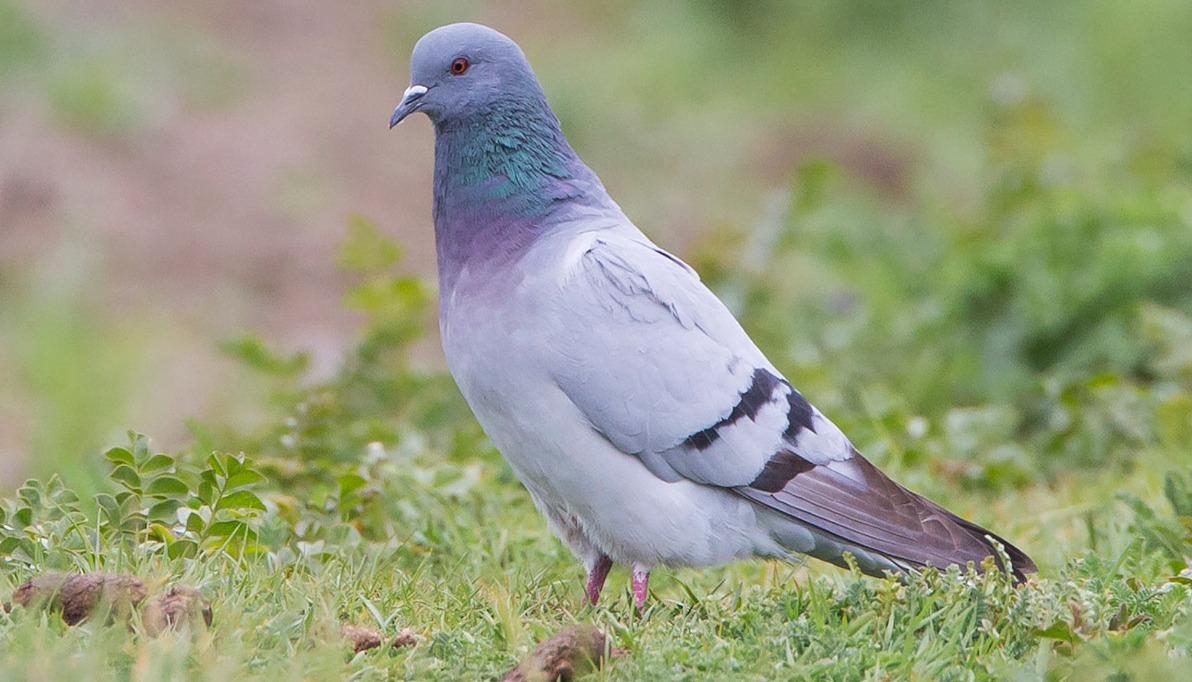 The rocky pigeon is smaller than its wild fellow.
The rocky pigeon is smaller than its wild fellow. The rocky pigeon is often confused with the gray-gray brethren due to external similarity, but this is only at first glance. The color of the plumage is lighter in this species of birds, and the color of the tail feathers is not as dark as in the previous breed.
And also the sizes of individuals differ: rocky pigeons are slightly smaller than sisaris. Most often, this species can be found in the highlands of Korea, Altai and Tibet. Birds make their nests and prefer to live in pairs.
"Klintuh"
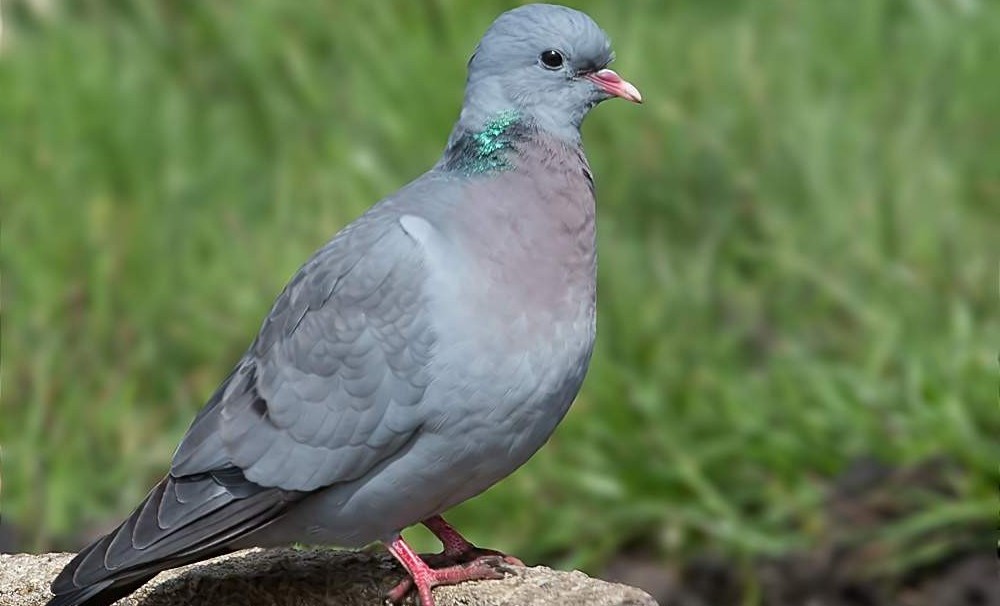 Pigeon clintuh has a straight tail.
Pigeon clintuh has a straight tail. This type of bird can be found in Africa, China, Turkey and other countries. The pigeon of this breed is easily distinguished by its unusual plumage, greenish shade of feathers on the neck and dark lines in the color of the tail.
This species of pigeons prefers to lead a sedentary life, but birds, whose habitat are areas with a changeable climate, fly to warm regions for the winter. Most often, individuals of this breed can be found in forests and park areas.
"Ringdove"
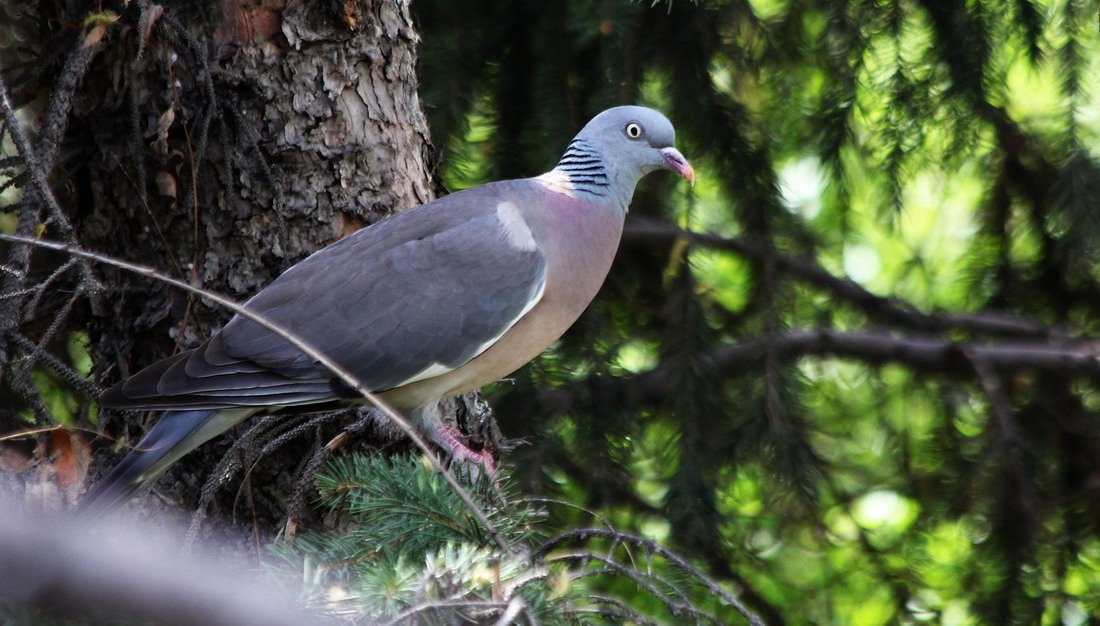 Wood Pigeon or Turtledove - the most elegant and graceful of wild pigeons.
Wood Pigeon or Turtledove - the most elegant and graceful of wild pigeons. Pigeons of this breed are larger than other wild bird species. And although its color has significant similarities with previous species, it is impossible to confuse them, the individual has impressive dimensions, and the tail length is 15 cm or more.
Individuals of this species are distinguished by the ability to adapt well to the particularities of the climate in almost any terrain. For living birds of the Vyakhir breed, forests and city parks are most often chosen.
Dove "Crowned"
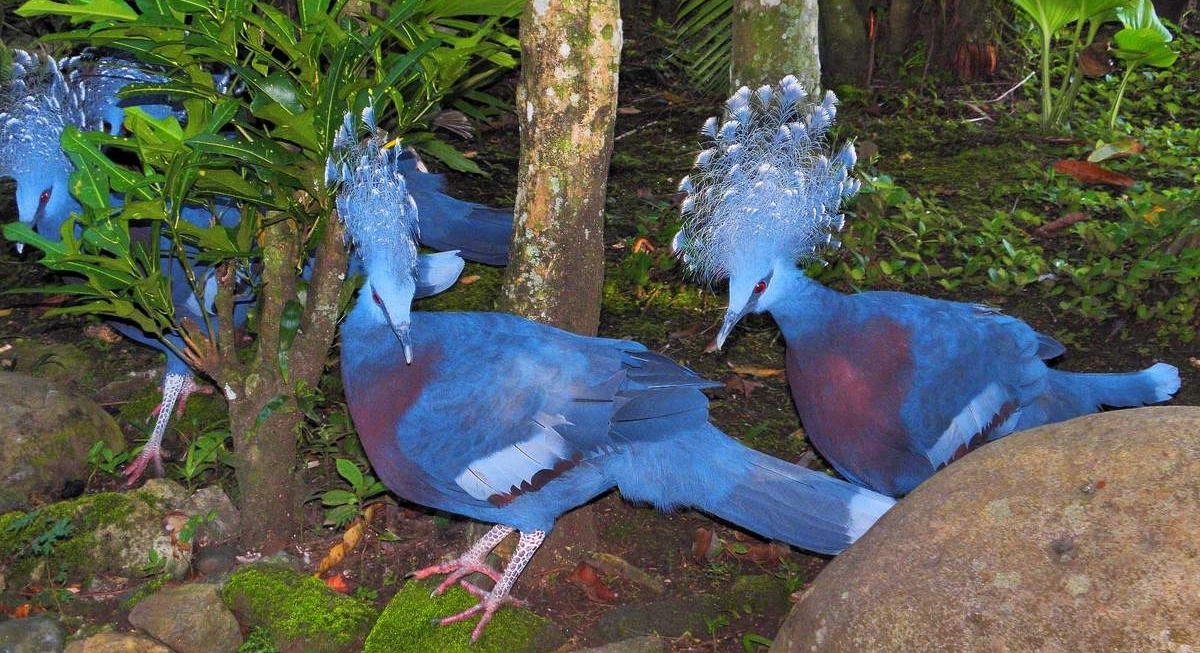 Crowned pigeon is more like a peacock or other exotic bird.
Crowned pigeon is more like a peacock or other exotic bird. This bird received its name due to its unusual appearance - the head of an individual is decorated with a tuft or “crown” of feathers.
The breed is almost unknown to most people and has not gained popularity among breeders because it has a limited habitat. You can only meet these pigeons in countries with a warm climate.
Interesting! Most often they choose marshlands, jungles and large forests with a high level of humidity.
Flying pigeons
Flight breeds of pigeons are capable of gaining a great height when flying and being held in the air. But in order to train some species of these birds, it will take a lot of effort.
Attention! Before giving preference to one or another breed of flying pigeons, a breeder needs to carefully study the description of the species in order to have a clear idea of the characteristics of these birds.
Nikolaev pigeon
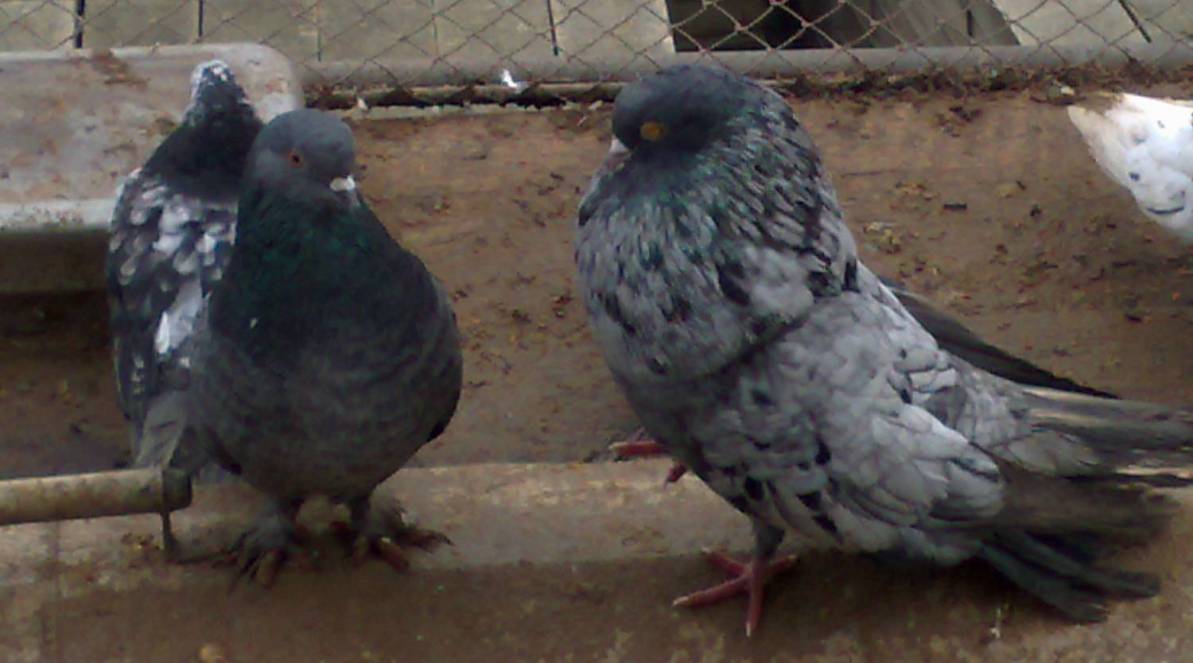 Breed of the Nikolaev pigeons - the most widespread among fans.
Breed of the Nikolaev pigeons - the most widespread among fans. The color of individuals may be the most diverse: red, blue, white or black. The distinctive features of the pigeon include short legs and strong, well-developed wings.
Due to this, the bird is perfectly adapted for high flights and can be kept in the air, making intricate “pirouettes” with its wings. This type of pigeons is widespread among breeders since.
Short-eyed turman
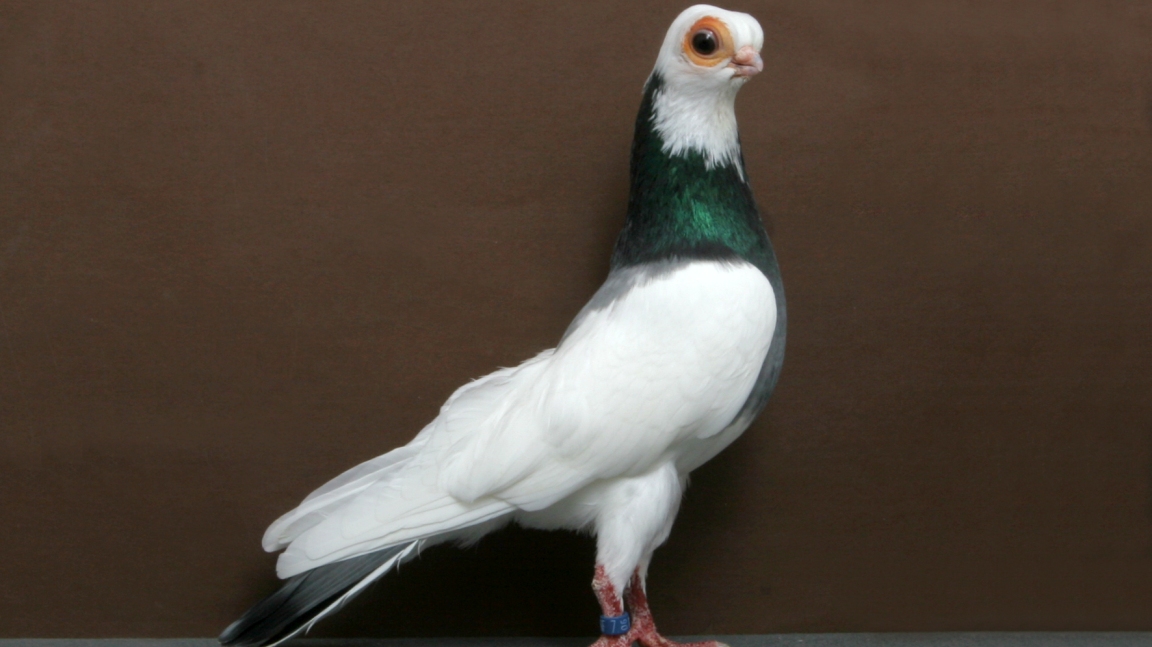 Pigeons of this breed have ideal flight characteristics.
Pigeons of this breed have ideal flight characteristics. As the name implies, the main distinguishing feature of this bird is its short, strong beak. Also, the individual has a bulging forehead and long, strong wings. As a rule, their color is uniform and almost monochromatic, but you can also find short-beaked Turmans with a mixed shade of plumage.
The pigeon of this breed does not differ in massiveness and large size. This feature allows the bird to quickly gain altitude when flying and easily kept in the air.
German monk
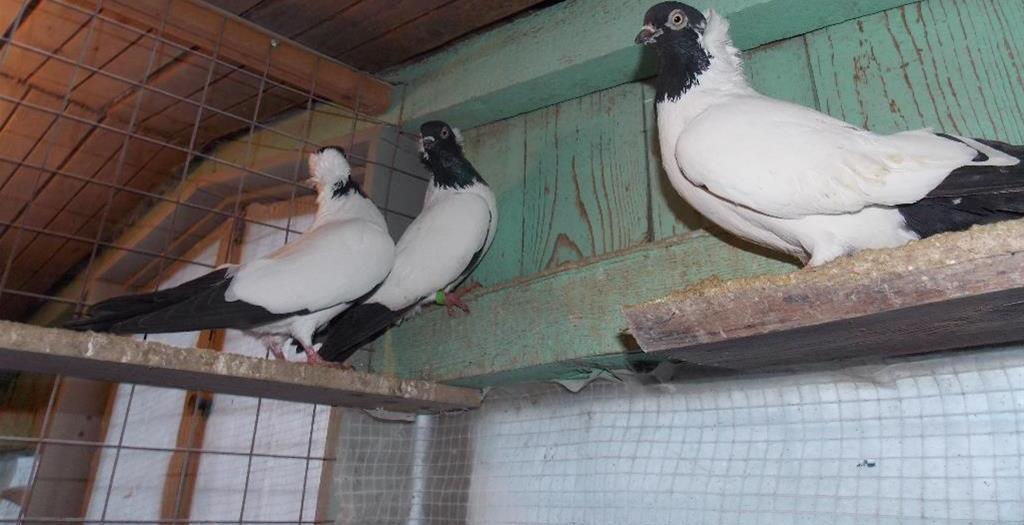 A distinctive feature of the monk is the crest.
A distinctive feature of the monk is the crest. The name of this breed suggests that Germany is the birthplace of the bird. This species first appeared in the XVII century.
A German monk stands out among his fellows with an unusual appearance, and this bird cannot be confused with a pigeon of another species. The crest or crest is located on the back of the head of the individual, which is the main distinguishing feature of the breed.
The color of individuals is different: white, brown, blue, silver and red.
Long billed berlin
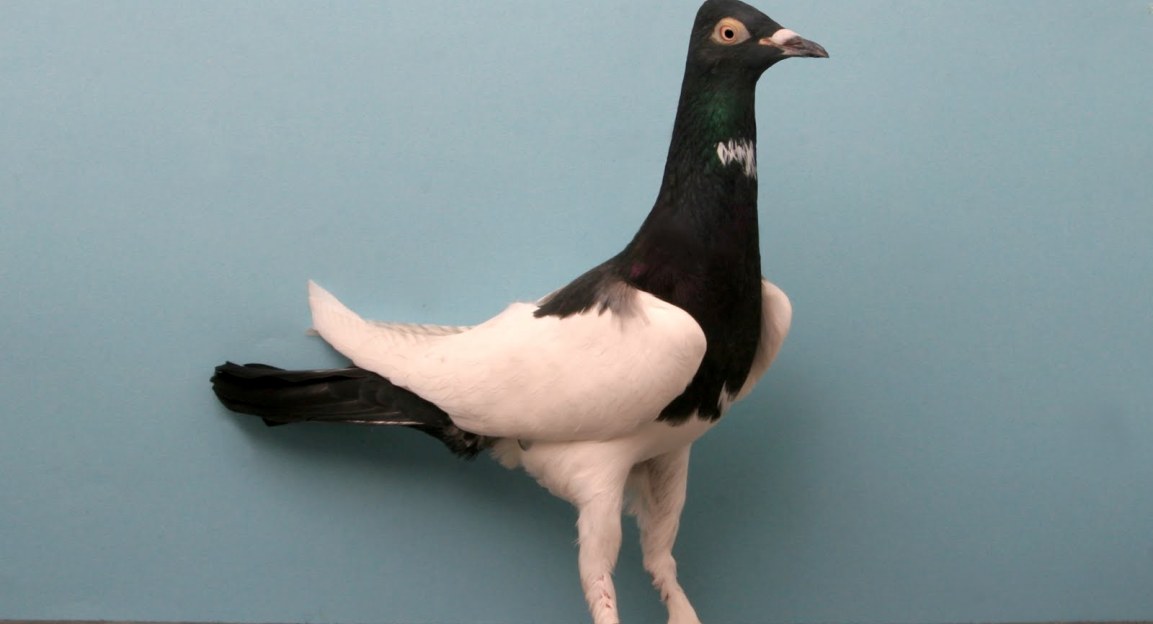 The Berlin pigeon is a big rarity in Russia.
The Berlin pigeon is a big rarity in Russia. This breed of pigeons was not widely spread, and to see a beautiful bird in some areas of Germany is considered a great success.
Individuals attract attention with their unusual appearance - a long beak, a small and narrow head, as well as a horizontal body. This pigeon is popular with German breeders due to its original appearance.
Post (sports) pigeons
Birds of sporting or postal varieties have the ability to cover significant distances and good orientation in space, they always come back.
If in the Middle Ages these birds were used as "postmen", then today, with the development of information technology, such a need has disappeared. Today, representatives of the postal species can be found at various competitions.
Belgian Dove
 The Belgian pigeon is considered the best mail.
The Belgian pigeon is considered the best mail. The capital of "pigeon sport" is Belgium. The breed of the same name is distinguished by its broad chest and small tail, which allows individuals to develop a good speed during the flight. Another distinguishing characteristic that does not allow confusing the bird of this breed with the relatives of other species is the smooth and silky plumage.
This breed is one of the best. These birds are not only champions in speed, but also in value.
English quarry
 This breed of pigeons is famous for its excellent orientation in space.
This breed of pigeons is famous for its excellent orientation in space. The breed was bred on the basis of its Asian kinsmen. A characteristic feature of the bird is the presence of skin folds in the area of the beak and eyes. Pigeons of this species are distinguished by a large body shape, strong beak and long tail. The feathers of the bird are short and rigid, tight to the body.
Individuals are capable of developing good speed and are perfectly orientated in space, but due to the peculiarities of their appearance, they are more close to decorative species of birds than to sports varieties.
Decorative species
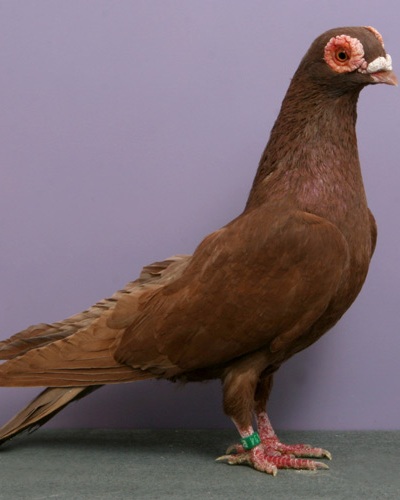 Dove breed Barb.
Dove breed Barb. Ornamental species of pigeons are most popular with breeders.
Such birds can be immediately recognized by their appearance, since they differ from their relatives by the following features:
- the presence of a tuft;
- original color;
- long feathers;
- shaggy paws;
- special posture and shape of the body.
The main purpose of breeding work in this case is to improve the appearance, these birds do not possess any other outstanding qualities.
"Barb"
These birds have a monochromatic color of feathers, the color can be different. The main features of this species include the following characteristics:
- bulging forehead;
- small beak;
- presence of growths in the eye area.
This pigeon looks very unusual and is very popular with both domestic and foreign breeders.
Dove "Dutysh"
Despite the name, in appearance the bird looks quite slim. In individuals of this species, there is a long, narrow body and paws of unusual shape.
Another characteristic feature of the species is the presence of a large goiter. Thanks to this, the bird of breed "Dutysh" cannot be confused with other varieties of decorative pigeons.
Bohemian Cosmonogue
Already from the name it is clear that the birds of this species have a very rich plumage on the legs. The limbs are covered with long, beautiful feathers with an unusual pattern. The wings of an individual also attract attention - they have a complex, “chess” pattern.
Curly Dove
 The curly pigeon is a very expensive breed.
The curly pigeon is a very expensive breed. Curly pigeons are particularly beautiful and unusual. They have a luxurious not monophonic plumage, consisting of small curls, “curls”. These birds are standards of beauty and are distinguished by high cost.
Meat pigeons
Among the wide variety of pigeon species, meat breeds stand out. A distinctive feature of these birds are large body size and inability to long flights. Also the pigeon breeder should know. In Russia, the breeding of these species is not so common, and in Europe, gourmands appreciated the taste qualities of diet pigeon meat.
"King"
 Meat breed pigeons with an unusual format of the body.
Meat breed pigeons with an unusual format of the body. The breed was bred in the 19th century, the largest individuals were selected for breeding work. These pigeons have a strong skeleton and a large body, their wings are weakly developed and the bird is not able to make long flights. The color of feathers can be monophonic and mixed, the birds of this breed are white, brown or black.
"Modena"
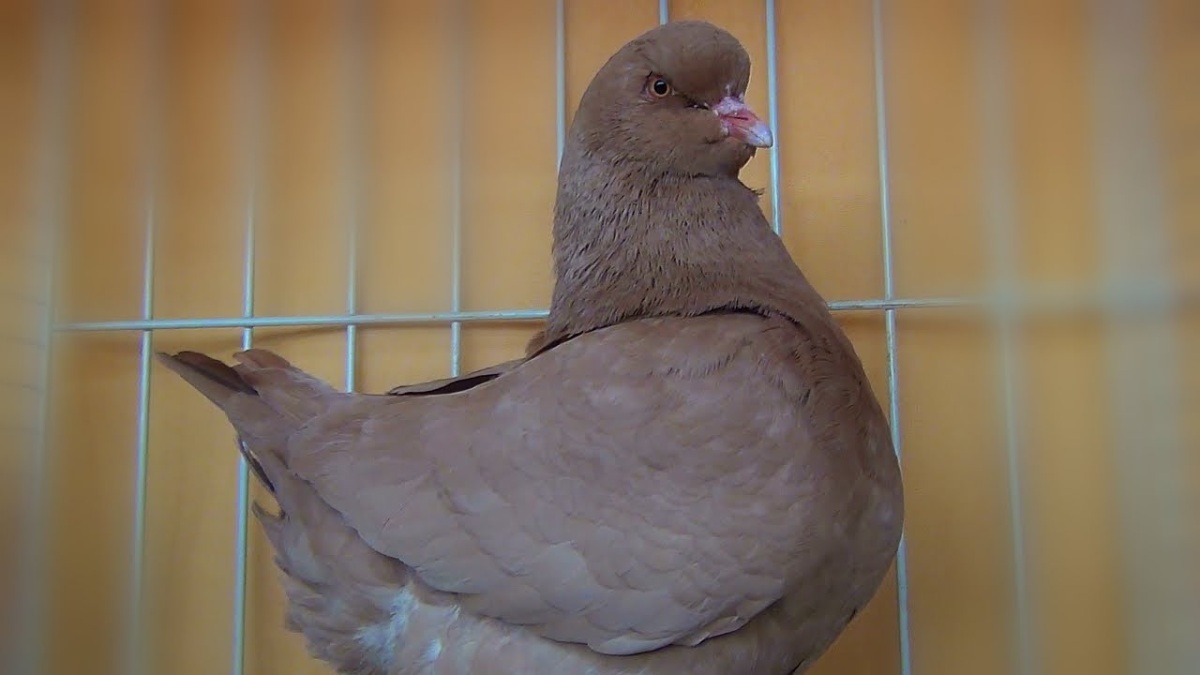 Dove breed Modena can not fly.
Dove breed Modena can not fly. These pigeons grow to large sizes, gaining weight up to 1 kg. For this reason, the bird is practically unable to fly. The color of the individuals is uniform, and sometimes the darker feathers on the body are combined with the light plumage of the wings. A distinctive feature of the species - perpendicularly growing tail.
Carnot
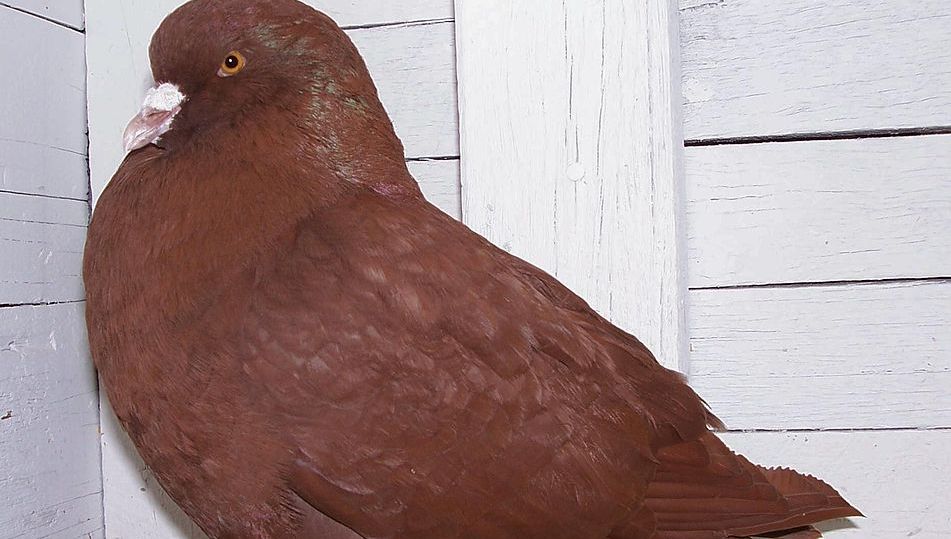 Pigeon breed Carnot different delicious taste of meat.
Pigeon breed Carnot different delicious taste of meat. These birds quickly gain weight, although they do not differ in large sizes - the body weight of an adult individual rarely exceeds 700 g. Outwardly, the pigeon of this breed is not very attractive, its color is dark and solid. But the homeliness is compensated by the high quality of meat, due to which individuals of this species are in great demand among breeders.
"Monden"
This species of pigeons belongs to the largest and reaches a weight of more than 1 kg. The quality of meat is excellent, the output at slaughter is up to 60%. It is with these qualities that the bird of the breed "Monden" has earned popularity among breeders on many continents of the planet.
"Rome" and "Strasser"
The meat of these birds is rich in various useful substances and microelements. Individuals of this species are large, body weight at the time of slaughter exceeds 1 kg.
In addition to meat productivity, the breed is characterized by increased resistance to various diseases, which aroused high interest among breeders.
The peculiarity of birds is high reproduction, which contributes to their popularity among breeders. The weight of an adult bird reaches 1 kg. Meat pigeon breed "Strasser" high quality, fine-fibrous and tender.
"Teksan" and Prahna pigeon
 Teksan - the most prolific breed of pigeons meat.
Teksan - the most prolific breed of pigeons meat. Representatives of this breed occupy a leading position in the ability to reproduce offspring. This is their main difference from other meat species.
Birds of this breed have average body size, their mass reaches 1 kg by the time of slaughter, but exceeds this indicator in rare cases.
This bird is medium in size, characterized by fleshy body. The weight of an adult individual is about 800 g, the meat of the Prachy pigeons is soft and tender. This kind of fertility is not different, the reproductive abilities are on average.
These are only a few, the most common breeds of "birds of the world", in fact there are much more of them. But even a novice breeder will be able to easily find an inexpensive and unpretentious variety for home breeding.
The video shows some exotic breeds of pigeons:
 magicov.ru Secrets of magic.
magicov.ru Secrets of magic.
